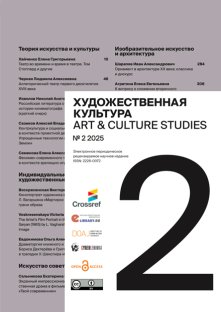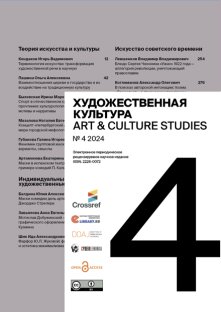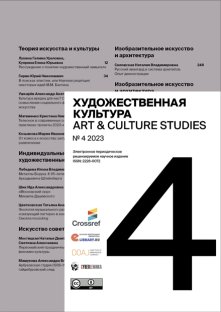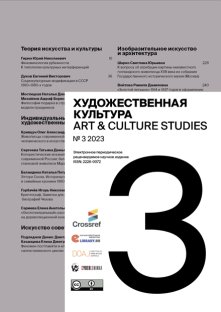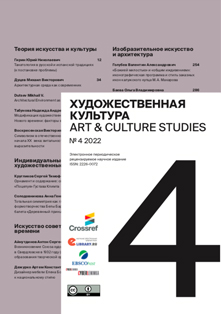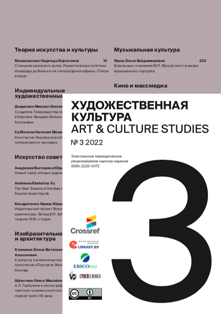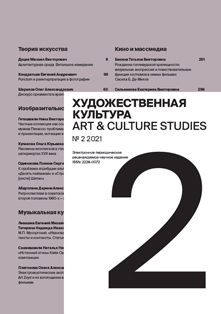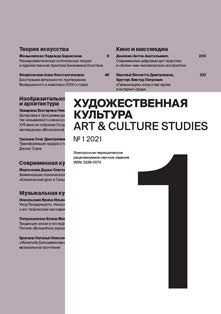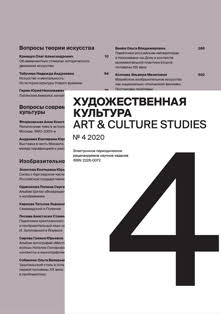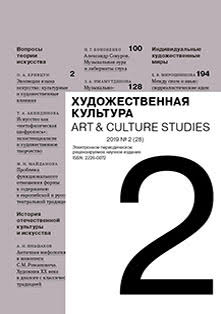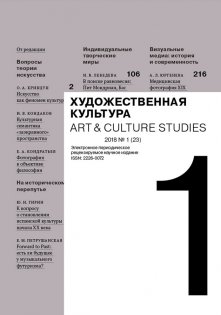Article Requirements
Structure of the text / Formatting of the article / Bibliography / References / Examples
The editorial board accepts original texts in Russian and English executed under the Art & Culture Studies requirements. Manuscripts, failing: to meet the requirements, to fit the journal`s thematic, and to pass plagiarism check are dismissed.
The original articles are presented by the editorial office e-mail: artculturest@mail.ru
STRUCTURE OF THE TEXT:
-
The size of the article (without metadata) must be 20,000–40,000 characters together with space characters. The number of characters can be increased by the decision of the editorial board.
-
The text must be unpublished previously, without any direct borrowings from the Internet. Originality is allowed not less than 80%. The previous author’s researches may not exceed 10% of the overall text of the article.
-
The title of the article must be laconic and contain the subject of study.
-
The article must be structured and represented the author’s concept. The text must be separated into paragraphs with subheadings (Introduction, Subheadings for main parts, Conclusion). The Introduction should present the subject, relevance, originality, problem, and goals of research formulated by the author. Next goes an overview of scientific research in the context of the topics under study. Additionally, the author should mark the place of his research in the existing scientific context. It is advisable to provide a brief overview of research methods used by the author and clarify terminology, if necessary. The article ends with a Conclusion with summarizes the research results of the author.
-
Abstract in Russian and English (180–220 words) is a brief overview of the article, must indicate the subject of research, scientific issues under study, the relevance, novelty, and significance of results and conclusions.
-
The bibliography list should contain scientific publications and include, among others, at least 5 academic sources from other countries published during the last 5 years, close to the theme of the presented article. Priority should be given to scientific works published with reputable publishers and scientific periodicals indexed in Scopus and Web of Science databases.
-
Footnotes are allowed for relevant brief comments and clarification but not for references.
-
Manuscripts and captions of the illustrative materials are provided in electronic form in separate files in Microsoft Word (See below for details). Figures are provided in the TIFF/JPG formats and named with the author’s surname and ordinal number: e.g. Surname-Fig-1, Surname-Fig-2. We kindly ask to use simple numbering: e.g. Fig. 1, Fig. 2, etc. Complicated numbering (e.g. Fig. 1.1, Fig. 1.2, Fig. 1a, Fig. 1b, etc.) is not allowed. The maximum allowable number of figures is six.
Above the text of the article items are placed:
-
Indices of Universal Decimal Classification (UDC) and Library Bibliographic Classification (LBC);
-
The information about the author or authors includes academic degree, academic title, work position, department or faculty, place of work/study, postal address of the organization;
-
ORCID ID;
-
Researcher ID;
-
Scopus Author ID (if available);
-
Email address of the author or authors;
-
Title of the article;
-
Abstract (180–220 words);
-
Keywords (5-10 words);
-
Information about Source of Financing (Grant Giving etc.);
-
Acknowledgments.
-
The all information above in English.
FORMATTING OF THE ARTICLE:
-
Articles are provided in the Microsoft Word. The font is Times New Roman, size 14 pt.
-
In-text citations should be placed after quotations and include the last name of the author, year of publishing, page number, all enclosed in square brackets. See below for details.
-
All references of the fiction literature, including poetry, must be given with a full bibliographic description.
-
Outer quotation marks “guillemets” (herring-bones) are used; inner quotes marks are presented as the “inverted commas” (or “double-quotes”).
-
The Russian dates should not be abbreviated. Not “g” or “gg” but “year” or “years”.
-
There must not be any spaces between initials, e.g. K.S. Stanislavsky.
-
Illustrative materials are provided in electronic form in separate files in the TIFF/JPG formats with expansions of 300-600 dpi. The place of figures in the text is indicated as “Fig. 1”, “Fig. 2”, etc.
-
Schemes, graphs, and diagrams are provided in the TIFF/JPG formats. Tables are provided in separate files in Microsoft Word.
-
The author provides the captions to the illustrative materials in a separate file in Microsoft Word. The captions include full information: author, title, year of creation, material and size, storage location. For musical materials, the captions include the information about the performer, the year of recording, and the recording company.
-
If materials are located on Internet, non-museum spaces, they should have a source link (website, album, book, archive, author’s collection, etc.).
-
The list of illustrative materials captions must be represented both in Russian and in English.
BIBLIOGRAPHY:
-
The bibliography is listed at the end of the article. It is allowed to place archival sources in another list before bibliography and references. In case of using archive sources, they are listed in alphabetical order before the bibliography and named as “Sources”. In this case numbering of bibliography continues after the last source.
-
The surname of author/authors in bibliography’s list is drawn up in italics. For example: Agafonova N.A. Screen art…
-
In-text citations should be placed after quotations and include the last name of the author, year of publishing, page number, all enclosed in square brackets. For example: [Lotman, 1998, p. 2]. If source has several authors, first three must be indicated. For example: [Lukina, Kuprina, 2023, p. 26-27]. The publication/eds. monographs are indicated as first part of the title. For example: [Lexicon of Nonclassics, 2021].
-
All sources are listed in alphabetical order under the established standard GOST 7.05–2008 (“Bibliography references”) as a numbered list. The font used for the author’s names is Italic. The total number/range of pages must be indicated at the end of the bibliographic description.
-
In the text of the article, the sources are given in the order of their position in bibliography list in square brackets. For example: [7, p. 16], [12, p. 38; 18, pp. 2–3]. All mentions and quoiting should be accompanied by the author’s comments.
-
The number of research without the indication of the page numbers may not exceed 10% of the overall number of references in the text of the article.
-
Each source in the list of bibliography must be quoted at least once within the text itself, indicated (except anonymity cases, etc.). Quoted scientific sources should correspond with the author’s concept, indicate similar points of view and methodological emphases or, demonstrate different scientific opinions.
-
Scientific or literary texts published on the Internet must be indicate of the authorship and the date of allocation. Reference to the web page and date of the access must be included in the bibliography description.
-
Self-quoting is allowed. Authors should not mention more than two or three previously published works and must include them in the bibliography list.
REFERENCES:
-
References in Cyrillic should be transliterated and located separately from the bibliography. The numbering must match with the bibliography list in Russian.
-
Transliteration applies only to the sources in Cyrillic. For transliteration online services should be used, e.g. http://translit.net or http://translit-online.ru
-
Surnames of Russian authors are transliterated. References in other languages are given in the original.
-
The publisher’s imprint in Russian (place of publication, volume, issue number, page number) is translated into English. The city of publication is not abbreviated: e.g. Moscow, Paris; Volume = vol.; issue number = no.
-
Titles of books, articles, and collections in Russian are transliterated and translated into English. The translation is given in square brackets […] after transliteration.
-
The source of the publication puts in italics (name of the journal, proceedings, or book).
-
The Russian titles of scientific journals are transliterated. If the journal has its official title in English, it can be indicated in square brackets.
-
After transliterating the name of the publishing house, it is necessary to add “Publ.”.
-
Punctuation marks: Russian quotation marks « » should be changed to English “ ”; sign // is changed to a full stop; sign / is changed to a comma. After the place of publication, colon is replaced by a comma.
-
All datas after the title of the journal are separated by a comma. For books, all details after the name of the city are separated by a comma.
-
Page numbers are indicated as follows: 15 p.; pp. 30–35. If the source is in German, page numbering is preserved: S. 18.
-
After each transliterated source, the language of publication should be indicated: (In Russian).
-
If a reference source has a DOI identifier, it must be specified.
EXAMPLES
Bibliography:
-
De la Fuente E. The ‘New Sociology of Art’: Putting Art Back into Social Science Approaches to the Arts // Cultural Sociology. 2007. Vol. 1. No 3. P. 409–425. https://doi.org/10.1177/1749975507084601.
-
Feder T., Katz-Gerro T. Who Benefits from Public Funding of the Performing Arts? Comparing the Art Provision and the Hegemony-Distinction Approaches // Poetics. 2012. Vol. 40. Issue 4. P. 359–381. https://doi.org/10.1016/j.poetic.2012.05.004.
-
Freshwater H. Theatre & Audience. Basingstoke: Palgrave Macmillan, 2009. 86 р.
-
Ginters L. On Audiencing: The Work of the Spectator in Live Performance. Sydney: Dept. of Performance Studies, University of Sydney, 2010. 269 р.
References:
-
Agafonova N.A. Ekrannoye iskusstvo. Khudozhestvennaya i kommunikativnaya spetsifika. Monografiya [Screen Art. Artistic and Communicative Specificity. A Monograph]. Minsk, BGU kul’tury i iskusstv Publ., 2009. 273 p. (In Russian)
-
Boyarskiy I.Yа. Literaturnyye koLLazhi [Literary CoLLages]. Moscow, 1996. Available at: http://www.pereplet.ru/text/boyarskiy.html. (accessed 30.01.17) (In Russian)
-
Kazyuchits M.F. Neigrovoye. Eksperimental’nyy i dokumental’nyy fil’m v SSHA, Kanade i Rossii 1950–2000 gg. [The Non-Fiction Film. The Experimental and Documentary Film in the USA, Canada and Russia between the 1950-s and the 2000-s]. Moscow, Akademiya mediaindustrii Publ., 2016. 166 p. (In Russian)
-
Krivulya N.G. Osnovnyye tendentsii avtorskoy animatsii Rossii 60-90-kh godov [The Main Tendencies of Authorial Animation in Russia between the 1960s and the 1990s]. Thesis for Dissertation for the Degree of Candidate of Arts, 17.00.03, Moscow, 2001. 187 p. (In Russian)
-
Sokolov K.B., Siyuhova A.M., Dvornik F.S., Bykanova E.V., Sputnickaya N.Yu., Gurov O.N. Fenomen tekhnologicheskogo. Gumanitarnye aspekty [A Technological Phenomenon. Humanitarian Aspects]. Hudozhestvennaya kul’tura [Art & Culture Studies], 2021, no. 3, pp. 564–599. https://doi.org/10.51678/2226-0072-2021-3-564-599. (In Russian)
Captions for Illustrations:
-
Fig. 1. Still from Late for a Date, directed by Mikhail Verner and Sergei Sidelev, 1936. Source: kino-teatr.ru
Ил. 1. Кадр из фильма «Девушка спешит на свидание», режиссеры Михаил Вернер и Сергей Сиделев, 1936. Источник: kino-teatr.ru
-
Fig. 2. Poster for A Sixth Part of the World, directed by Dziga Vertov, 1926. Source: Film.ru
Ил. 2. Афиша фильма «Шестая часть мира», режиссер Дзига Вертов, 1926. Источник: Film.ru
-
Fig. 3. La Corte Verde residential complex. Milan, Italy. Cino Zucchi, Filippo Poli. 2006–2013. Photo by M.V. Dutsev
Ил. 3. Жилой комплекс La Corte Verde. Милан, Италия. Архитекторы Ч. Дзукки, Ф. Поли. 2006–2013. Фото М.В. Дуцева
-
Fig. 4. M. Shirman. High School Graduates on the Palace Embankment at White Night. Leningrad, 1970
Ил. 4. М. Ширман. Выпускники школ на Дворцовой набережной в Белую ночь. Ленинград. 1970. ЦГАКФФД СПб. Фотодокумент. Ар. 191139.
-
Fig. 5. Makovsky V.E. Night. 1879. Oil on canvas. 62 × 77 cm. State Russian Museum, St. Petersburg
Ил. 5. Маковский В.Е. Ночное. 1879. Холст, масло. 62 × 77 см. Государственный Русский музей, Санкт-Петербург
